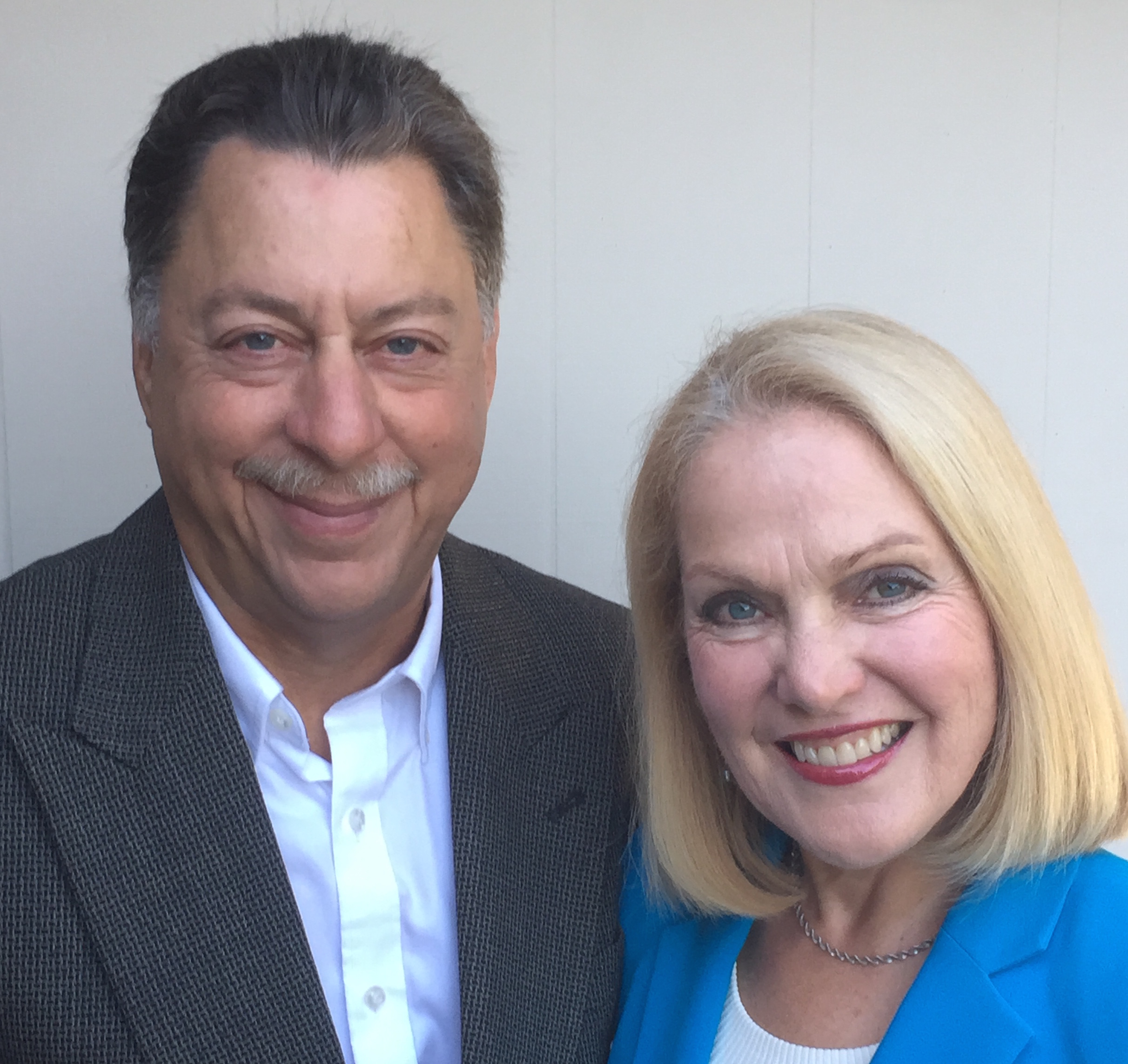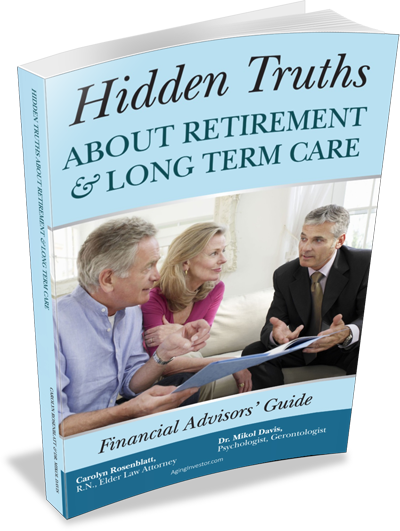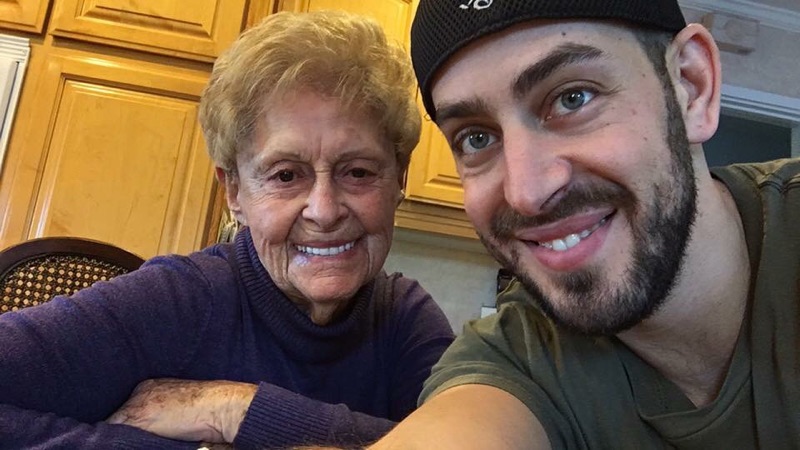
Jul 11, 2019 | aging, aging in place, cost of aging, diminished cognition, elderly, health, resources for senior, resources for seniors, retirement planning
Does The Advisor Have A Role With Aging Clients Who Become Unsafe Living Alone?
Carolyn Rosenblatt, RN, Elder law attorney, AgingParents.com
You’ve known the client for many years. As time passes and she lives longer than she thought she would, you see her inevitable decline. She loses her husband, on whom she depended. She doesn’t want to move to assisted living or anywhere, even if you think it would be best for her. Her vision is dimming and her hearing isn’t good either. She has refused all help even when you reassured her she could easily afford whatever she needs.
Is there anything you can do? You care about the client but you’re used to just managing the money, and it isn’t clear that you are obligated to go beyond that. But you know that your client just isn’t safe alone anymore.
In these situations, the most competent advisors and wealth managers can feel conflicted about their roles. They have over the years come to know the client well and there is a sense of wanting the client to be safe. At the same time, maybe it’s not an advisor’s problem. What about the family? What if there is no family?
The first thing every advisor should do is what the regulators make optional for you: “try” to get a trusted third party contact. From our vantage point at AgingInvestor.com and AgingParents.com, we think it’s ridiculous to consider it an option rather than a requirement to get a trusted contact on file. The advisor can be more trusted than family in some cases and has a unique vantage point. YOU are the one who may be first to see your client’s decline and need for greater safety in the client’s living situation. You need to have someone to call. If it’s family and they are willing to step in, good. If there is no family, the client must be advised to hire a licensed person who is capable of overseeing their care if needed and to assist with day-to-day finances. The term “fiduciary” has a different meaning in the context of your industry, but outside it, a fiduciary can be a person whom the state licenses to manage money for someone who is not able to do it alone. They serve in the capacity similar to that of a conservator, guardian or power of attorney appointee, but the aging person still maintains some control as long as he or she remains cognitively intact. For those with no family a licensed fiduciary can solve the question: who can the client count on to help?
Even when there is family the aging client can still resist moving to a senior’s apartment in a community rather than struggling on living alone. It happened in our own family. It took two years for Dr. Davis’ mother, Alice to make up her mind to give up living alone in a house. To see a short video, Alice’s perspective of her decision. Click HERE.
At age 90, she had vision and hearing problems, arthritis, leg pain, unstable blood pressure, kidney and bladder issues and she took 14 pills a day. That by itself was not enough to get her to agree to move. She ultimately reached the decision because she got tired of the daily difficulty she had trying to maintain independence.
Even with your efforts to persuade a client that he or she ought to consider some new choice like assisted living, remember that a person who is competent can’t be forced to move anywhere. Logic has nothing to do with the fear of losing one’s independence. But keep trying and do work with the client’s family on a joint plan to help your client get to a safe decision.
What Action Can You Take?
Can you tell your client’s family about your observations? We see no ethical dilemma at all here. This is not about financial matters necessarily though it can be. The cost of moving and paying for care is a factor. But no one says you have to talk about what’s in your client’s portfolio. To be in the best position in anticipation of a client who is declining with age, get your client to identify any family or friends who could be called upon “in case of emergency”. Get more than one trusted contact. If you have a few people on the list identified by your client, call a phone meeting and discuss strategy. Gentle persuasion can work over time as it did with 92 year old Alice, who finally decided to move into a senior’s apartment. She was mighty stubborn but it did work out in the end, absent disaster. We were fortunate.
The takeaways from AgingInvestor.com:
Anticipate that long-lived clients may become unsafe living alone. Most people over age 80 need some kind of help in their lives.
You as the trusted advisor can be ready for age-related decline in your clients by having several trusted contacts in your client’s file whom you know and can call upon when safety is an issue.
If you become aware that your client is losing independence and should not be living alone, call a phone meeting with the trusted contacts to develop a strategy for working together to help your client make a good decision about moving or bringing help in.
Expand your role of merely managing the money and use your position of trust to help your client and the family keep the client physically safer.
If this all seems to be an awkward and uncomfortable thing to address, get a consultation from experts on aging at AgingInvestor.com. Our nurse-lawyer, geriatric psychologist team offers you expertise in how to approach a problem with an unsafe client and even what words to use to help them with important safety decisions.
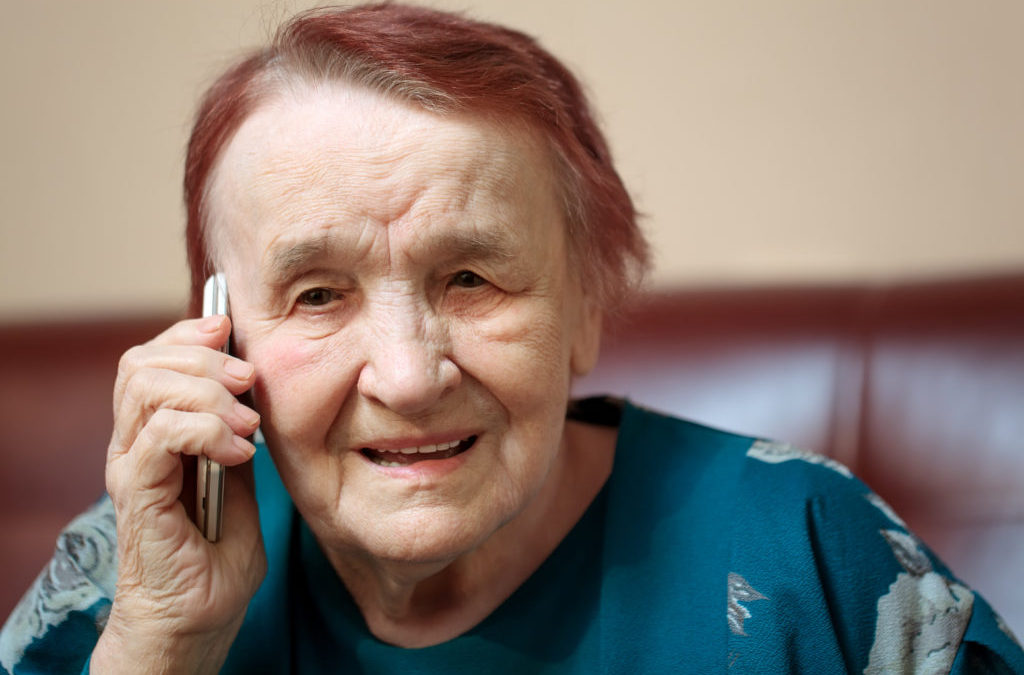
Apr 25, 2019 | aging, aging investor, declining health, diminished cognition, elder investor, elderly, finances for elders, financial advisors, financial capacity, financial judgement, handling money for seniors, health, senior investor, seniors finances
Clients Without Family: Financial Planning With “Elder Orphans”
Every financial advisor will eventually come across an aging client who is essentially alone in the world. The elder may be single, widowed, or otherwise without a partner. Some are members of the LGBTQ community and never had children. Others were childless, or have lost children and significant others in their long lifetimes. The end result is that the usual support systems that exist for others are not available to these clients when they may need support the most.
Some refer to these elders who are alone with no family as “elder orphans”.
Heidi is an example. She has a financial advisor who has worked with her over decades. He referred her for advice, which she wanted and I visited her at home. She is 90 and lives alone in her own house, which she owns outright. She has a modest portfolio and is comfortable. She was widowed 20 years ago and she has no children, nor any relatives in the U.S. She relies on her best friend and neighbor when she needs help. This need is increasing now that her vision is impaired. When I spoke with Heidi I asked her about her one best friend. She mentioned that this neighbor is 86, but is “doing pretty well”. Heidi had recently fallen twice in her home, but fortunately escaped serious injury from those falls.
Heidi has a will and a trust, power of attorney and healthcare directive. The appointed person on those documents is her cousin who lives in another country. If an emergency occurs, it is not at all clear who would be available to assist her.
This situation is a disaster waiting to happen. The risk of another fall, vision problems that will likely prevent her from driving, and the age-related risks to her friend the 86 year old who could also become disabled or unavailable are all looming. I ask if her financial advisor has discussed the future with her, possible other living arrangements, a local person for a healthcare agent and what to do when she can no longer drive. “No” she replies, “we’ve never gotten into that”.
I urged Heidi to contact her financial advisor right away so plans could be made and her safety assured. She also needed to speak with her estate planning attorney to update her documents, ensuring that an appointed local person had authority to assist in any crisis or if Heidi loses independence. She is close to needing help now.
Think about your book of business and whether you have any “elder orphans” in it. If so, there are things any responsible advisor should address with such clients. Here are three essentials for every advisor’s discussion.
- First, the legal documents. The advisor can get permission from the client to contact the estate planning attorney and find out what plans exist for an appointed person to step in and take over the reins when or if the client becomes impaired. a local appointee is critical. Someone has to be able to make financial decisions if the client loses the ability to make them independently.
- Next, alternative living arrangements. A 90 year old with impaired vision who has fallen at home may need to consider options of where to live with help available onsite. The financial advisor knows what assets are available to pay for a choice such as assisted living. The advisor should bring this up and ask the client about what he or she wants.
- The need for a local appointed person to be not only the advisor’s trusted contact, but your client’s person to reach in the event of an emergency. An appointee in another country is not going to be of immediate help. Explore other choices.
The advisor needs to expand the limits of the usual role of simply managing the money with elder clients who do not have any family. To keep you on track and aware of the special planning these aging investors need, get your free checklist of points to address at AgingInvestor.com. With it, you can be sure of what you need to cover in your planning conversations with you “elder orphan” clients. Download Your Advisor’s Seven Point Checklist— Best Planning For Aging Clients With No Family now so you can excel in appropriate future planning.
Carolyn Rosenblatt, RN, Attorney, AgingInvestor.com

Feb 21, 2019 | aging, aging investor, cost of aging, cost of long term care, declining health, elderly, finances for elders, financial advisors, handling money for aging parents, handling money for seniors, health, long term care insurance, resources for senior, resources for seniors, retirement planning, senior citizen investor, senior investor, seniors finances
It used to be that we could think of retirement in a kind of predictable way. People lived into their 70s perhaps, and we measured retirement by that. We used tables, algorithms and other tools to tell us how much we should save and how much we could spend in retirement. And it was all based on assumptions that may no longer apply.
Life expectancy for a woman in the U.S. in 2018 was 84 years. For a man, the figure is 80 years. Those averages do not take into account the fact that well educated and financially secure people live longer than average. This is presumably based on the notion that people who know what a healthy lifestyle is and who can afford the best medical care will outlive those who do not have those advantages. In my own county, for example, which has a high proportion of elders compared to other counties in California, one wealthy city shows a life expectancy for men of 93 years.
Suppose that your aging client lives to be 93, having retired at age 65. That’s 28 years of retirement. What the algorithms don’t clarify is what you, the advisor needs to plan for with your client during the last decade of life, from 83-93. No formula is going to help you with the individual discriminations you need to make concerning your client’s risks for care and how to assess and plan for them. They can be a substantial cost, out of pocket, not covered by Medicare, and absolutely necessary.
The way we age is determined by two main factors: hereditary tendency and lifestyle. Our genetic makeup directs only about 30% of the equation. The other 70% is driven by the way we choose to live our lives. There are plenty of folks who think that a healthy lifestyle is just too much bother. They avoid exercise, eat whatever they feel like eating, never learn to manage stress and say they’d rather die a few years sooner than give up their habits, which their doctor advises against.
Here’s the problem with that belief. Leading an unhealthy lifestyle does not just cause you to “die sooner”. Rather, it may likely cause you to live with impairments, disabilities and a need for expensive long term care for chronic health conditions. These can go on for decades.
Take obesity, for example. Over two-thirds of Americans are overweight or obese. Obviously excess weight increases our risks for all manner of health issues, including diabetes, heart disease, high blood pressure, and strokes. When a doctor makes a diagnosis of one of these, the person doesn’t typically just die on the spot and save a lot of expense later on. No. The medical providers will keep the person going with medications, surgery in some cases, lots of diagnostic monitoring and trips to the doctors. These chronic conditions usually lead to disability late in life, particularly when more than one of them exists in the same person.
If you have aging clients, you definitely need to understand health risks in a basic way, so that you can help your clients set aside funds for the care they are likely to need in the last years of their retirement lives. All of the chronic conditions I mentioned are manageable with an effort toward a healthy lifestyle but for those who do not wish to do the work involved, you can bet on a likely need for long term care. While you can’t predict the future, you can plan for risk. It’s what you do.
My own mother in law had high blood pressure and chronic kidney disease for decades. She worked vigorously at diet, exercise, social activities and other components of a healthy lifestyle. Heredity was not on her side. She lived to be 96. During the last 3 years of her life, she needed help. She moved to a seniors’ community where help was available and eventually, she paid for private caregivers. Her cost of living at the last part of her life was $120,000 a year. If this were your client, would he or she have at the ready $360,000 to pay for care? How about if there was no pursuit of a great lifestyle? The care expense could easily be 10 years.
The takeaway here is that advising for longevity needs to include the skill of assessing fundamental health risks that create a need for out of pocket, long term care. You don’t need to be a doctor and you can’t predict everything, but you can do what is reasonable to help your client plan. Ask the right questions. Keep track of your client’s general health picture.
To learn more about what to look for and what to ask, get Hidden Truths About Retirement & Long Term Care, available at AgingInvestor.com and on Amazon.
By Carolyn L. Rosenblatt, RN, Elder law attorney, AgingInvestor.com
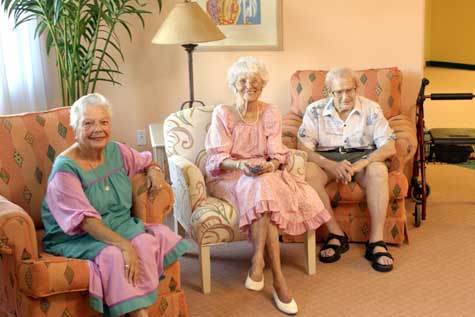
Feb 5, 2019 | aging, cost of aging, cost of long term care, custodial care, declining health, elderly, finances for elders, financial advisors, handling money for aging parents, handling money for seniors, health, long term care, nursing home, resources for senior, resources for seniors, retirement planning, seniors finances
The financial services industry often refers to retirement planning for the future with aging clients in terms of “housing choices”. This reflects some degree of misperception about what happens as we age. For healthy people of retirement age, there is little interest in planning for the need for care and planning for loss of independence. People usually resist talking about it. We don’t choose to lose our independence. It happens. It is up to the advisor to raise it if you want to advise for longevity. The subject is emotional and can be difficult.
Where we need to get help when we can’t be independent any longer is really a choice about care, rather than housing. This is not house shopping. Does a client want to pay for care in her own home when that time comes? Most would say yes, they want to remain at home. They then must calculate what a home care worker costs and whether that is the best way to receive the help they are likely to need one day with their activities. Can the resources be available to enable that choice of where care will be given?
If an elderly client is living alone and can’t manage at home anymore without assistance, there are indeed choices, often driven by the degree of care needed and the cost of getting it. Elders may not be interested any longer in maintaining a house, cooking, shopping, and other necessary chores. For them, assisted living may be desirable because their daily lives will be different and free from the burden of the household that has become unmanageable. The choice to go to assisted living is usually not one a client is going to make because of wanting to downsize into an apartment for its own sake. Rather that is the price of going to the place where assistance is on hand. Again it is to receive care, not because they love the idea of not having their home any longer. For many elders, downsizing from a house to an assisted living apartment is a difficult adjustment, required because of physical or mental changes of aging. From that perspective it is a choice forced upon them.
A factor every advisor should know is that the likelihood of living alone increases with age. Almost half of women age 75+ lived alone in 2010, according to the Institute on Aging. The “choice” of a different living arrangement is brought on by safety and care concerns, often raised by their adult children.
It will be good for every advisor who wants to help clients plan for longevity to consider that their role is to introduce the issue of possibly needing care in the future, as about 70% of us will one day. If your client has you in her life, she already has housing. Planning for “housing” is a misnomer. Focus on places and choices where care can be delivered. Having no care plan can be disastrous, as sudden health crises can force decisions without considering the cost of care in advance.
In helping to educate your client about where he or she can receive care, the costs of all the offerings available in most areas are spelled out in detail in our book, Hidden Truths About Retirement & Long Term Care. You can develop quick expertise on the subject there. Skilled advice about longevity for your aging clients requires knowing your numbers, what care options are available where they live and how much they can expect to spend for that care. Smart advisors gather the data before a crisis happens and urge clients to look at it with them.
By Carolyn L. Rosenblatt, RN, Elder law attorney, AgingInvestor.com

Jan 28, 2019 | aging, aging in place, aging investor, cost of aging, cost of long term care, custodial care, declining health, diminished cognition, elder investor, elderly, finances for elders, financial advisors, financial capacity, financial elder abuse, financial judgement, handling money for seniors, health, long term care, nursing home, resources for seniors, seniors finances
Your clients are getting ready for retirement. You’ve done the calculations, balanced the portfolio and advised them of what income to expect. You’ve discussed how much spending is ok. You used your program and your analysis was thorough. You’ve done your job, right?
Not exactly. There is probably no algorithm nor program that will calculate your client’s individual profile of health risks that will likely lead to the expense of long term care. That can be a whopper. Maybe you’ve suggested long term care insurance. Most people don’t choose to buy it. For those who do, the benefits are limited and the “elimination period” (deductible) is thousands of dollars. There go your careful calculations. At least 90% of folks don’t have that coverage. Now what?
But how can you predict what’s going to happen to anyone’s health in retirement, you ask. You can’t be precise, but you surely can make some rational observations and give advice accordingly. Those observations consist of two parts: what you can see with your own eyes and what you can glean by asking a few basic questions. If you think asking any client about their health conditions is too nosy or not your job, consider that if the client needs long term care and runs out of money because of it, they’re not going to think much of you. And the cost can wipe out their security.
Asking about health issues is not nosy at all. Rather, it’s what any smart advisor planning for longevity must do. Let’s not keep pretending that everyone stays the same physically and mentally from the start of retirement to end of life. Our bodies go through wear and tear and things break down. Cognitive decline affects at least a third of people who reach the age of 85. The risk of Alzheimer’s disease keeps climbing after that. Now, what was that life expectancy you were using in your calculation? Was it age 99?
Let’s start with what you can see in your client with your own eyes. (If they’re not in front of you, perhaps Skype is an option). Is your client obese, as about 40% of the U.S. population is? This leads to heart disease, stroke, and diabetes, among other diseases and conditions. The medical care people receive in many cases will save them from dying but they then live with disabilities. And yes, they will be very likely to need expensive long term care. Neither health insurance nor Medicare will cover long term care. Such help as a part time caregiver at home is how most folks start out with long term care. Your client pays out of pocket most of the time. Did you calculate how much it costs as well as how long they will likely need it? If they have multiple medical conditions, and have started long term care, they’ll probably continue to need some form of it for all their remaining years.
Find out what you may not know from simply observing your client’s appearance by asking questions. You can make your own list or get a health care provider to help you with a few targeted questions. You will need to educate your client as to the reason why you need this information. It’s to help them plan for how much to save in their retirement years.
Here are some examples of basic questions that can help you predict the need for possible long term care:
- How’s your health these days? Has a doctor told you that you have any long term conditions?
- Are you taking medications? What are they for?
- Do you smoke?
- Are you concerned at all about any health issues you have at this time?
Do you recall your parents’ ages when they died?Your aging clients will not be eager to talk about the potential need for long term care. When you told them about what to expect for “out of pocket medical costs in retirement”, you did not give them a figure that included long term care. Long term care is not “medical” according to Medicare. Rather, it is called “custodial care”. The client probably will not bring it up, so you must do this.
When you have done your observations and gotten answers to your health-risk related questions at least there is a place to start a meaningful conversation. You can give them figures as to the cost of typical kinds of care, such as a non-medical home care worker. We at AgingInvestor.com recommend starting your projections at age 80 as to when a person might need physical help. Many of us know someone who did require help with at least some part of his or her life at that age. Then you can talk about how any condition your client identifies for you, such as high blood pressure, diabetes, etc. as shortening normal life expectancy and increasing the risk for needing help. If your client already has difficulty with some normal daily activity such as walking or bathing, they are definitely at high risk for needing paid help sooner than a person without these problems.
Clients may be completely unaware of such things as the hourly cost of a home care worker, what assisted living costs each month and what home modifications cost if they are able to remain in their own home. You can find a thorough discussion of these and many other parts of long term care in our book, Hidden Truths About Retirement & Long Term Care, written specifically for financial advisors like you.
Every conscientious advisor needs to wake up to the reality that your retirement income calculator omits the reality check of health problems. We’re not talking about nursing homes, but every other kind of care and help most people will need as they age. If you do want to help clients who are reaching retirement age to plan realistically, include the health risks you can see or learn about by asking.
By Carolyn L. Rosenblatt, RN, Elder law attorney, AgingInvestor.com
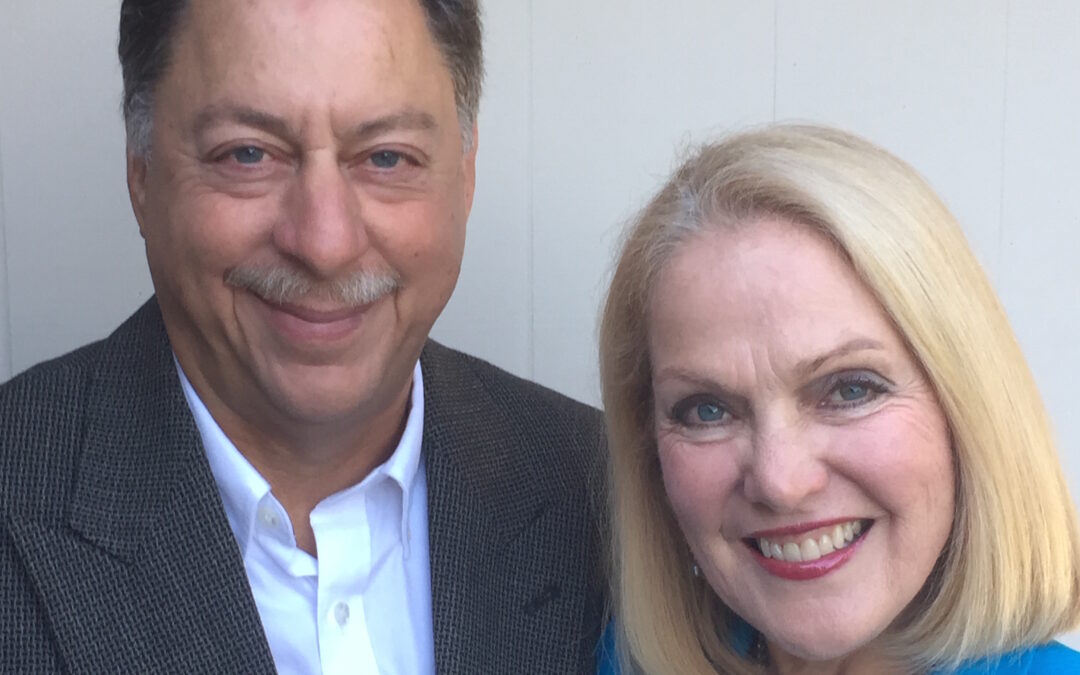
Jan 24, 2019 | aging, aging in place, declining health, diminished cognition, elderly, financial advisors, health, long term care, resources for seniors

Jan 18, 2019 | aging, aging in place, aging investor, cost of aging, declining health, elderly, finances for elders, financial advisors, handling money for aging parents, handling money for seniors, health, long term care, resources for seniors, retirement planning, seniors finances
Most advisors who even ask this question of their
retirement-aged clients never spend time on it. About 90% of those asked say
they want to remain in their own homes as long as possible. That sounds fine. Until one faces physical
decline, cognitive impairment or both. The advisor providing competent guidance
about financing aging at home had better know the facts.
None of us like to think about losing physical ability or needing help. We abhor the thought of losing our total independence. In our view at AgingInvestor.com, the only advice clients are getting is about the long term picture is whether or not to purchase long term care insurance. Since most people don’t do that, the actual costs of living at home can boggle the mind. It’s the best advisor’s obligation to educate your client about the risks of the plan to age in place, just as it is your obligation to educate them about balancing their portfolios. You are giving the client added value if you take the time to talk them through the risks and dollars they may need to have available.
Here are some briefly stated facts from a real case in which
an 89 year old wanted to age in place and his wife promised he would never have
to leave home.
At the outset of his declining health, he had about $3M in
invested assets. His portfolio was healthy and balanced for his age, according
to conventional wisdom. He began to lose his ability to walk due to multiple
medical problems. His wife hired home helpers, three days a week at first. As
his conditions progressed he needed more and more help. He had to have a wheelchair, and a special
van. A stair chair was installed in their two-story home. By the time he
reached age 95, he was spending over $150,000 a year on care and assistance
around the clock. In the space of time during which he was steadily losing
independence until he passed away at 95, his assets were depleted to the tune
of $2M. He lived in a higher end market for the needed help but the reality is
that in any market, the kind of care he needed would be very expensive.
For him, aging in place was more costly than a skilled
nursing facility would have been. Home modifications, private caregivers, (none
of whom were licensed nurses), equipment, medications, adaptive devices, etc.
drained his resources by 2/3. And not everyone has as much invested as he had
to even start the journey. His wife had her own assets and she paid the cost of
household maintenance, taxes, food, and utilities with her funds. Had she
relied on him for those things too, there would likely have been little left at
the end of his life.
It is not all doom and gloom however. Many clients live rather well in their last years without all the care this gentleman needed. Some get by with family caregiving help, and some have fewer medical conditions. But if you are going to competently help your clients plan for longevity, it’s essential to understand the real out of pocket costs of aging in place or anywhere else outside the home. If you want to add value to your services to older clients, know what they need to know to properly anticipate what can happen with living into one’s 90s and beyond. Learn all the actual costs of care for every aging client option in our book, Hidden Truths About Retirement & Long Term Care. Be well prepared to walk your client through the scenarios they could face in their futures. You distinguish yourself from other advisors when you sharpen your knowledge in planning for longevity.
By Carolyn Rosenblatt, RN, Attorney, AgingInvestor.com

Nov 15, 2018 | aging, aging investor, cost of aging, cost of long term care, custodial care, declining health, elder investor, elderly, finances for elders, financial advisors, financial capacity, financial judgement, handling money for aging parents, handling money for seniors, health, investor, long term care, seniors finances
Your clients are getting ready for retirement. You’ve done the calculations, balanced the portfolio and advised them of what income to expect. You’ve discussed how much spending is ok. You used your program and your analysis was thorough. You’ve done your job, right?
Not exactly. There is probably no algorithm nor program that will calculate your client’s individual profile of health risks that will likely lead to the expense of long term care. That can be a whopper. Maybe you’ve suggested long term care insurance. Most people don’t choose to buy it. For those who do, the benefits are limited and the “elimination period” (deductible) is thousands of dollars. There go your careful calculations. At least 90% of folks don’t have that coverage. Now what?
But how can you predict what’s going to happen to anyone’s health in retirement, you ask. You can’t be precise, but you surely can make some rational observations and give advice accordingly. Those observations consist of two parts: what you can see with your own eyes and what you can glean by asking a few basic questions. If you think asking any client about their health conditions is too nosy or not your job, consider that if the client needs long term care and runs out of money because of it, they’re not going to think much of you. And the cost can wipe out their security.
Asking about health issues is not nosy at all. Rather, it’s what any smart advisor planning for longevity must do. Let’s not keep pretending that everyone stays the same physically and mentally from the start of retirement to end of life. Our bodies go through wear and tear and things break down. Cognitive decline affects at least a third of people who reach the age of 85. The risk of Alzheimer’s disease keeps climbing after that. Now, what was that life expectancy you were using in your calculation? Was it age 99?
Let’s start with what you can see in your client with your own eyes. (If they’re not in front of you, perhaps Skype is an option). Is your client obese, as about 40% of the U.S. population is? This leads to heart disease, stroke, and diabetes, among other diseases and conditions. The medical care people receive in many cases will save them from dying but they then live with disabilities. And yes, they will be very likely to need expensive long term care. Neither health insurance nor Medicare will cover long term care. Such help as a part time caregiver at home is how most folks start out with long term care. Your client pays out of pocket most of the time. Did you calculate how much it costs as well as how long they will likely need it? If they have multiple medical conditions, and have started long term care, they’ll probably continue to need some form of it for all their remaining years.
Find out what you may not know from simply observing your client’s appearance by asking questions. You can make your own list or get a health care provider to help you with a few targeted questions. You will need to educate your client as to the reason why you need this information. It’s to help them plan for how much to save in their retirement years.
Here are some examples of basic questions that can help you predict the need for possible long term care:
- How’s your health these days? Has a doctor told you that you have any long term conditions?
- Are you taking medications? What are they for?
- Do you smoke?
- Are you concerned at all about any health issues you have at this time?
- Do you recall your parents’ ages when they died?
Your aging clients will not be eager to talk about the potential need for long term care. When you told them about what to expect for “out of pocket medical costs in retirement”, you did not give them a figure that included long term care. Long term care is not “medical” according to Medicare. Rather, it is called “custodial care”. The client probably will not bring it up, so you must do this.
When you have done your observations and gotten answers to your health-risk related questions at least there is a place to start a meaningful conversation. You can give them figures as to the cost of typical kinds of care, such as a non-medical home care worker. We at AgingInvestor.com recommend starting your projections at age 80 as to when a person might need physical help. Many of us know someone who did require help with at least some part of his or her life at that age. Then you can talk about how any condition your client identifies for you, such as high blood pressure, diabetes, etc. as shortening normal life expectancy and increasing the risk for needing help. If your client already has difficulty with some normal daily activity such as walking or bathing, they are definitely at high risk for needing paid help sooner than a person without these problems.
Clients may be completely unaware of such things as the hourly cost of a home care worker, what assisted living costs each month and what home modifications cost if they are able to remain in their own home. You can find a thorough discussion of these and many other parts of long term care in our book, Hidden Truths About Retirement & Long Term Care, written specifically for financial advisors like you.
Every conscientious advisor needs to wake up to the reality that your retirement income calculator omits the reality check of health problems. We’re not talking about nursing homes, but every other kind of care and help most people will need as they age. If you do want to help clients who are reaching retirement age to plan realistically, include the health risks you can see or learn about by asking.
By Carolyn L. Rosenblatt, RN, Elder law attorney, AgingInvestor.com

Apr 17, 2017 | aging, declining health, elderly, financial capacity, financial judgement, handling money for aging parents, health, resources for senior, resources for seniors, Uncategorized
What To Do When Your Aging Client’s Health Is Failing
Financial professionals can find themselves in an uncomfortable position when they have a long time aging client who is in declining health. Of course, you know the client and can see that she’s struggling with a lot of issues. You may want to do something but this stuff is just not in your wheelhouse. Longevity is great but not when you start to lose the ability to manage on your own. What are you supposed to do for these clients?
You’re trained to understand economics, taxes, financial products, planning. But you’re not trained to direct aging people to whatever resources they may need as they get older. If they have family, you may expect family to step up, but you see that it may not be happening. Should you call them? Do you even know them? Do you have your client’s permission? And what if they don’t have family? That’s even worse. Here they are getting frail and more vulnerable by the day and you are just watching helplessly.
It doesn’t have to be that way. You can get acquainted with some basic resources in your area and the areas where your clients live. Maybe they never figured they’d live so long as to actually need help. When they do, you can be a starting point to help them find what’s out there.
Let’s imagine you have an aging client who is having trouble getting around and she needs some help with chores at home. She tells you about it when you ask her how things are going. She is shy to ask for help and reluctant to admit that it’s harder and harder to live alone. You don’t know what to say. Or do you?
One source of help everyone should know about is the Area Agency on Aging. These Federally funded programs connect elders to appropriate community organizations and places to get assistance. Their mission is to help older adults and people with disabilities live with dignity and choices in their homes and communities for as long as possible.
AAAs contract with local service providers to deliver many direct services, such as meals, transportation and in-home services. However, most agencies are direct providers of Information and Referral/Assistance, case management, benefits/health insurance counseling and family caregiver support programs.
Some are incorporated into a county’s health and human services departments. Some are separate. Large states have many AAAs. Smaller less populated states have fewer of them.
One thing you can do now to be ready to assist your own client who may demonstrate a need is to research where the nearest Area Agency on Aging is in your client’s community, download a brochure or information package and let your client know it’s there. If he needs help at home, transportation services, vetted information about local service providers, an AAA is a great place to start.
This whole aging client issue can be a reflection of things you have experienced in your own family. Perhaps you have an aging parent or ill grandparent. Another problem solving source of information is our book the Family Guide to Aging Parents: Answers to Your Legal, Healthcare and Financial Questions
. Learn what’s in it here. It can get you more comfortable with those difficult conversations.
Carolyn Rosenblatt, RN, Elder law attorney
AgingInvestor.com and AgingParents.com







